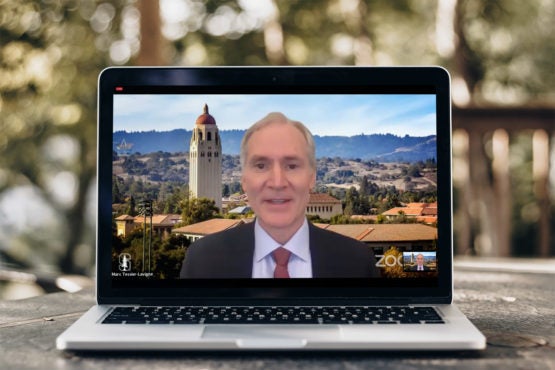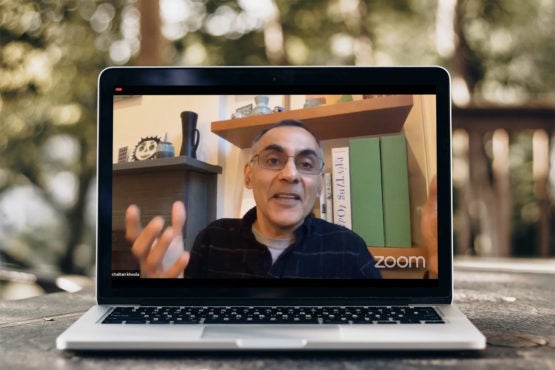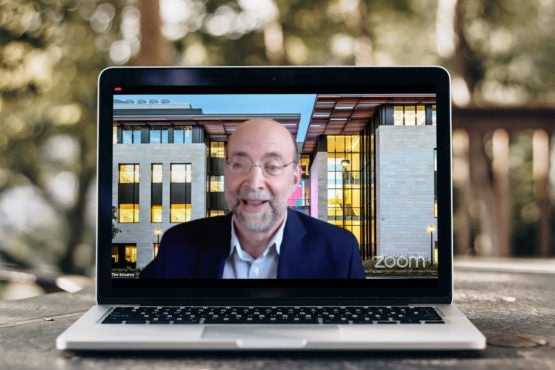Stanford pivots its Long-Range Vision to contribute to global recovery
At the Academic Council meeting, President Marc Tessier-Lavigne discussed how Stanford is pivoting its Long-Range Vision in light of COVID-19, and announced Stanford is designing a school focused on climate and sustainability. Professor Chaitan Khosla described the new Innovative Medicines Accelerator. Professor Tim Stearns presented the annual report of the Senate of the Academic Council.
At the Academic Council meeting Thursday, President Marc Tessier-Lavigne said Stanford has the opportunity to “make the next leap forward” in discovery, teaching and innovation, even in this very uncertain moment when a pandemic has disrupted life around the world.

President Marc Tessier-Lavigne addressing the Academic Council at its annual meeting. (Image credit: Andrew Brodhead)
“One thing I am certain about is that this current moment has confirmed the importance and the relevance of our Long-Range Vision,” Tessier-Lavigne said, speaking to the Stanford community during the first livestreamed meeting of the Academic Council.
During his annual address, Tessier-Lavigne provided an update on the Long-Range Vision, which is designed to guide Stanford for the next decade and beyond. The goals of the Long-Range Vision fall under three themes: Solutions for the World; Knowledge for Humanity; and Education for a Life of Purpose.
He described how the university is “pivoting” that vision in light of COVID-19 to include contributing to global recovery in the near term.
In addition to the immediate need to help address the current crisis, Tessier-Lavigne discussed how the university’s vision applies to seeking solutions for the ongoing climate crisis with the creation of a school focused on climate and sustainability.
A history of navigating crises
He reminded the audience that Stanford has navigated upheaval and tragedy before, and even in those difficult times continued to make progress as an institution.
“These crises have sometimes forced the university to adjust course,” Tessier-Lavigne said. “But they have never derailed it. In fact, they sharpened our focus and helped illuminate what this community could achieve to benefit the world.”
In the near term, Stanford will continue to address urgent priorities created by COVID-19, from keeping the community safe to addressing the effects of the economic downturn on the university’s budget.
“At the same time, we are looking to the vision to provide a framework to help align our resources, strengthen our partnerships and pivot our work to address the needs of our community, nation and the world in this time of crisis,” Tessier-Lavigne said.
He provided several examples of how Stanford is pivoting its Long-Range Vision to contribute to the global recovery:
- Stanford Impact Labs: Fellows are exploring how to address issues of food insecurity and housing with partners in the region, and tackling the impact of technology on the well-being of youth, an issue that will become more of a concern as schools move online.
- Transforming Education: During this intense experimentation in online learning, Stanford has the opportunity to develop new models that offer a more equitable and effective education for all learners, based on what we learn during this pandemic.
- Undergraduate Financial Aid: The economic fallout from this pandemic will undoubtedly mean that in the coming years more students and families will require financial aid. Stanford is committed to maintaining a robust financial aid program now and in years to come.
- Graduate Student Support: Stanford is also committed to minimizing the impacts of the pandemic for graduate students and postdoctoral scholars. The university has provided them with additional financial resources for unanticipated expenses related to COVID-19.
Tessier-Lavigne said the crisis has highlighted Stanford’s ability to make a difference in the world, which will be a different place when the pandemic ends – in ways large and small.
Focus on sustainability
In addition to the near-term focus on the COVID-19 crisis, the Long-Range Vision is also targeting the climate crisis, he said.
“What I am excited to share today is that we are moving forward with a school that brings together many of Stanford’s existing strengths in climate and sustainability together with a sustainability neighborhood and a translational accelerator, to further accelerate research, education and impact,” Tessier-Lavigne said.
“Though we are launching this effort in a time of fiscal constraint due to the coronavirus pandemic, we believe it is important to use this period to put in place the structures that will enable our long-term success, and enable us to build the initiative further once the current crisis has passed.” For more information about the school, read here.
As Stanford develops the structure, faculty and students will continue in parallel to carry out important immediate work in climate change, clean energy solutions and more, he said.
Tessier-Lavigne then introduced Chaitan Khosla, who is leading the newly created Innovative Medicines Accelerator (IMA), an initiative that emerged from the Long-Range Vision. Khosla is the Baker Family Co-Director of Stanford CHEM-H (Chemistry, Engineering & Medicine for Human Health), a professor of chemistry in the School of Humanities and Sciences, and the Wells H. Rauser and Harold M. Petiprin Professor in the School of Engineering.
Stanford’s Innovative Medicines Accelerator
Khosla said the challenge that the Innovative Medicines Accelerator – or IMA, for short – confronts is easy to articulate, but not easy to address.

Chaitan Khosla described the Innovative Medicines Accelerator at the annual meeting of the Academic Council. (Image credit: Andrew Brodhead)
“We all know that making a new drug is an extremely expensive effort,” he said. “We also know that making a new drug is an extremely risky undertaking. When you put these two things together – notwithstanding the fact that we are arguably in the era of biology in general and human biology in particular – most human diseases remain untreatable.”
He said the challenge of the IMA is to help Stanford address that unmet need.
Khosla said the goal of the IMA is to help Stanford investigators identify discoveries in their laboratories that allow an opportunity to create innovative medicines.
“Identifying those basic science discoveries that can spawn new medicines that can bring down [health care] costs and improve the quality of these services is a huge priority and opportunity for a university like Stanford,” he said.
The IMA was originally envisioned to overcome obstacles in developing medicines for everything from deadly diseases like cancer to rare disorders overlooked by most pharmaceutical companies.
But since the start of the COVID-19 pandemic, the IMA has focused its attention on helping researchers test their ideas about potential medicines for the novel coronavirus.
Khosla said Stanford may be unique among its peer institutions in the strength and breadth of the university’s response to COVID-19, which ranges from testing to care to therapeutics, basic science and epidemiology, and all of this has benefited from the capabilities that Stanford is seeking to put in place through the IMA.
For more information about the IMA and its current research projects, read here.
Report of the 52nd Senate of the Academic Council
Also at the Academic Council meeting, Tim Stearns, chair of the Stanford Faculty Senate, gave a brief report on the senate’s deliberations during the 2019-20 academic year.
Stearns is the Frank Lee and Carol Hall Professor in the Department of Biology in the School of Humanities and Sciences, and a professor in the Department of Genetics in the School of Medicine.
Stearns said the senate discussed two reports that shined a spotlight on what Stanford needs to do better as a community.

Tim Stearns, chair of the Faculty Senate, summarized that body’s deliberations for the academic year at the Academic Council meeting. (Image credit: Andrew Brodhead)
He said the Association of American Universities Campus Climate Survey and subsequent presentations by the Associated Students and Provost Persis Drell made clear the unacceptable prevalence of sexual violence, harassment and discrimination on campus, and helped focus thoughts on solutions.
He said the Report on Faculty Gains and Losses highlighted the limited progress Stanford has made on diversifying the faculty.
“Doing better here will require a concerted effort across the campus,” he said.
Stearns said one difficult decision the senate made earlier this year was to require spring quarter courses to be graded Satisfactory/No Credit, outside of the professional schools, after Stanford decided not to hold in-person classes as a result of the coronavirus pandemic.
In another meeting, the senate approved proposals to establish a Civic, Liberal and Global Education requirement for first-year students, enact new unit ranges for undergraduate majors, and require all undergraduates to complete “capstone” projects.
“There will be significant work to implement these changes,” Stearns said. “I will also note that some parts of this legislation remain controversial and there is a petition initiated by faculty within the School of Engineering to require a full Academic Council meeting to reconsider them. We will keep you updated.”
In the Q&A that followed the presentations, audience members asked questions on a wide variety of topics, including the creation of the school focused on climate change and sustainability, and use of the new, Stanford-developed online tool called Health Check to screen for temperature and any other COVID-related symptoms.
In addition, participants posed questions about plans to transform White Plaza into a vibrant town center and how instruction will take place during autumn quarter.
